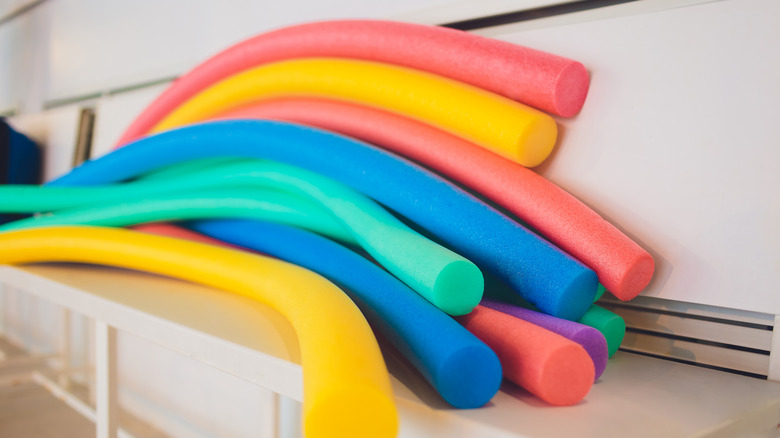Use This Pool Noodle Hack To Define Your Space In An Open Concept Floor Plan
We may receive a commission on purchases made from links.
Open concept and multi-use spaces can feel nice and spacious but often fail to provide necessary privacy or dedicated zone delineation that benefits functionality or design preferences. While a number of great ways of dividing rooms exist at all budget levels and price points, TikTok user @summerrayneco recently showed off an easy and ingenious use of pool noodles to create an innovative room divider that looks far more expensive than its price tag. By adhering pool noodles to a simple cardboard frame, she creates a divider for her salon workspace that looks like a luxurious velvet tufted wall.
This hack can work wonderfully to create privacy and zones in an open-concept space like a shared dorm room, studio apartment, or multi-use space like a guestroom/office. Even better, depending on how many pool noodles you use and the height of the partition, it can be created for well under $50 in supplies and materials, including crushed velvet fabric you can purchase at Fabric Wholesale Direct for $11.99 per yard, poster board you can get at Michael's for $1.99, and pool noodles, which will cost you $24.99 for a six-pack on Amazon.
Creating a tufted room divider
To create this DIY divider, start with several cardboard poster boards attached together with tape as the base. Then, adhere the pool noodles to the frame to form the ribbing. If you need more height, you can easily cut the pool noodles to fit your space. Take some hot glue or another sturdy adhesive to affix the foam pieces both to the cardboard and each other. While the cardboard is not initially sturdy, the addition of the foam pieces provides additional stability to the base. At this point, it's time to cover the foam pieces in the fabric of your choice, using a staple gun along each joint to give the whole partition a tufted fabric effect. In order to stabilize the partition, you can use a wall hinge and a 2-by-4 on both the front and the back to prevent it from falling over.
While this lightweight construction is simple, you can also use this format to create a heavier version by using a plywood frame instead of cardboard, which is particularly handy if you would like to make it a two-sided partition with foam pieces on both sides of the wall. The extra stability is also great for pieces that will be moved or repositioned since wood will hold up better than cardboard. For an even easier hinged version, use a ready-made simple dressing screen, like this one from Amazon, under the foam pieces.
